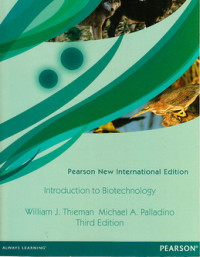Text
Introduction to biotechnology
If you have ever eaten a corn chip, you may have been affected by biotechnology. Don't eat chips? How about sour cream, yogurt, cheese, or milk? In this century, more and more of the foods we eat will be produced by organisms that have been genetically altered through biotechnology. Such genetically mod¬ified (GM) foods have become a controversial topic over the last few years, as have human embryos such as the one shown in the opening photo. This chapter was designed to provide you with a basic introduction to the incredible range of biotechnology topics. As you will see, biotechnology is a multidisciplinary science with many powerful applications and great potential for future discoveries.
In this chapter, we do not offer a comprehensive review of the history of biotechnology and its current applications. Instead, we present a brief introduction and overview of many topics. We begin by defining biotechnology and presenting an overview of the many scientific disciplines that contribute to this field. We highlight both historic and modern applications and define the different types of biotechnology that you will study in this text. At the end of the chapter, we discuss aspects of the biotechnology workforce and skills required to work in the industry. Be sure that you are familiar with the different types of biotechnology and the key terms presented in this chapter, because they will form the foundation for your future studies.
Advancements in biotechnology have progressed signifi¬cantly since sequencing of the human genome was com¬pleted in 2001. Genomes are being analyzed and genomic studies have roles in biotechnology. Recombined genes hold the potential to create new diagnostics and treat¬ments for diseases, and protein drugs that are hard to ad¬minister and assimilate can be absorbed through the skin when packaged in nanovesicles specifically designed for timed release. Bacteria can be used to make biofuels and ways to use synthetic genomes to create bacteria with novel properties will be discussed. Collaboration between nonprofits and biotech companies is accelerating the de¬velopment and public acceptance of transgenic plants. Vaccine development is one area of animal biotechnol¬ogy that is likely to reduce the cost of health care for humans and animals. DNA is used for identification in a number of ways including disease, paternity, and security. The creation of organisms to convert toxic materials to harmless substrates and other bioremediation techniques has received a boost from studies of the bacteria degrad¬ing the oil released from the 2010 Gulf of Mexico spill.
Ketersediaan
Informasi Detail
- Judul Seri
-
-
- No. Panggil
-
660.6 Thi i
- Penerbit
- London : Pearson., 2014
- Deskripsi Fisik
-
394 hal. : il. ; 28 cm.
- Bahasa
-
English
- ISBN/ISSN
-
9781292027616
- Klasifikasi
-
660.6
- Tipe Isi
-
-
- Tipe Media
-
-
- Tipe Pembawa
-
-
- Edisi
-
Ed. III
- Subjek
- Info Detail Spesifik
-
-
- Pernyataan Tanggungjawab
-
-
Versi lain/terkait
Tidak tersedia versi lain
Lampiran Berkas
Komentar
Anda harus masuk sebelum memberikan komentar

 Karya Umum
Karya Umum  Filsafat
Filsafat  Agama
Agama  Ilmu-ilmu Sosial
Ilmu-ilmu Sosial  Bahasa
Bahasa  Ilmu-ilmu Murni
Ilmu-ilmu Murni  Ilmu-ilmu Terapan
Ilmu-ilmu Terapan  Kesenian, Hiburan, dan Olahraga
Kesenian, Hiburan, dan Olahraga  Kesusastraan
Kesusastraan  Geografi dan Sejarah
Geografi dan Sejarah